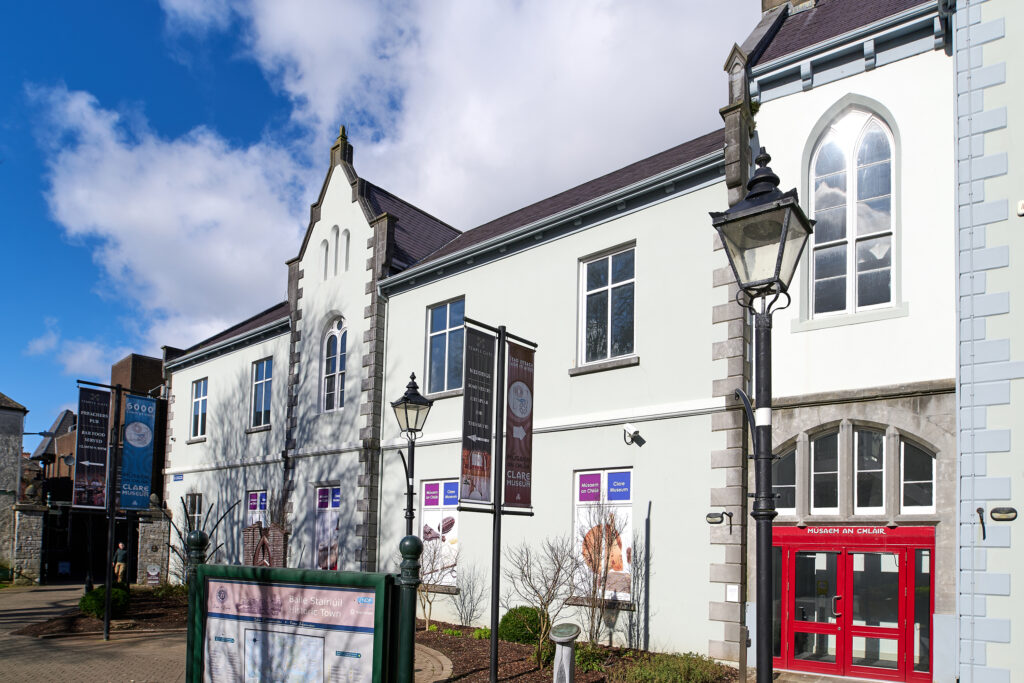Clare Museum opened in 2000, in a building that originally formed part of a Sisters of Mercy convent.
1854: A Sisters of Mary convent opened in Row House, Ennis. This building is now used as the Temple Gate Hotel, near Clare Museum.
The nuns were invited to Ennis by parish priest Dean John Kenny. They soon became involved in teaching. The site of their convent, Row House, had formerly been the home of Charles O’Connell, cousin of Daniel O’Connell. Daniel O’Connell had often visited the house in Ennis during his 1820s campaign for Catholic emancipation in Ireland.
1861 to 1869: The convent was enlarged to include a primary school and other buildings. The school building now houses Clare Museum and was built in 1865.
Due to a growing numbers of nuns, the convent was enlarged. As well as Row House (now the Temple Gate Hotel), the convent now included St Xavier’s primary school and chapel (now Clare Museum), as well as an orphanage, and several small industries.
1870s to 1990s: Nuns from Ennis went on to found convents abroad, as well branch houses and schools throughout Clare.
Sisters from the convent in Ennis founded further convents in America, Australia and New Zealand. Branch houses and schools were set up in Killaloe and Spanish Point in Clare. They also established Colaiste Muire school in Ennis. They worked as administrators and nurses in the workhouses in Ennis, Corofin and Roscrea.
1965: Separately, a local museum was opened on Bindon St, Ennis. The collection would later form part of the collections of Clare Museum.
This small museum was opened by Ennis Urban District Council.
1975: The local museum collection moved from Bindon Street into the new De Valera Library and Museum on Harmony Row.
The opening of this building was covered by RTE News at the time. The collection of objects there continued to grow over the years before eventually being moved to Clare Museum.
1994 to 1995: The Sister of Mercy convent buildings were sold to Ennis Urban District Council. The main building was demolished, and smaller parts remain, including the building now used by Clare Museum
Due to a declining number of nuns as well as deterioration in the condition of the buildings, the buildings were sold to Ennis Urban District Council in 1994. The main convent building was demolished in the following year, leaving behind the sections still standing today. The remaining sections include the building now used by Clare Museum, as well as the Temple Gate hotel nearby. The sisters moved to smaller accommodation, where their work continues to this day. Many of the schools they founded are still flourishing.
1995 to 2000: The remaining convent buildings were redeveloped by Ennis Urban District Council.
The surviving convent buildings had become derelict and added to the Derelict Sites Register. This led to the redevelopment of the building into a museum by Ennis Urban District Council. This was supported by Clare County Council and the Department of Arts, Heritage, Gaeltacht and the Islands. Funding of £1,000,000 was awarded from the Cultural Development Incentive Scheme, as part of the Operational Programme for Tourism 1994–1999. The character of the original building was retained during the redevelopment. The formerly dilapidated building was developed into a major cultural resource with a combined floor area of around 2,300 square metres.
1999: A tourist office was opened on the ground floor of the redeveloped convent buildings.
This was managed by Shannon Development and later Fáilte Ireland. It now opens during the summer months.
2000: Clare Museum opened to the public with the ‘Riches of Clare’ exhibition.
The collection from the De Valera Library and Museum was moved to Clare Museum. The Museum also received a large loan of Clare objects from the National Museum of Ireland, as well as from local collectors. It is the only museum in Clare with a collection from the National Museum of Ireland. Other rooms in the building were used as meeting rooms by Clare County Council and later by Limerick Institute of Technology
2002: Clare Museum became a designated building under the National Cultural Institutions Act 1997.
This official designation means that the Museum can serve as a place for safekeeping locally-found archaeological objects which would otherwise be sent to the National Museum of Ireland.
2005: Dr Patrick Hillery exhibition was held at Clare Museum. This was the Museum’s first major temporary exhibition.
Dr Patrick Hillery, born in County Clare, was the President of Ireland from 1976 to 1990.
2017: The Clare Embroidery Collection was donated to the Museum.
This is one of the Museum’s most significant collections, featuring samples made by an embroidery school in Clare in the late-19th and early-20th centuries.
2018: Clare Museum became a fully-accredited museum under the Museum Standards Programme for Ireland.
This accreditation, from the Heritage Council, means that Clare Museum achieves professional standards of managing, caring for the collections, and exhibiting the collections.
2019: A painting by Frederic William Burton was added to the Museum’s collections.
Burton lived in Clifden House, Corofin, County Clare as a child, and went on to become a significant 19th-century painter and Director of the National Gallery in London.
2022: Éamon de Valera’s car, a 1947 Dodge Limousine, was placed on long-term display at the Museum.
Éamon de Valera was the towering political figure in Ireland during the 20th century and was intimately connected to Clare, having represented the county from 1917 to 1959.
Today: Clare Museum is now a major cultural attraction in Ennis. The Museum’s collections of objects are continually growing. These objects can also be explored online, along with their stories.
As well as Clare Museum, the museum building also houses art exhibitions from Clare Arts Office, and a Tourist Information Office in the summer months. Other rooms in the building are used for museum activities, as well as offices for Ennis 2040 and meeting rooms.
